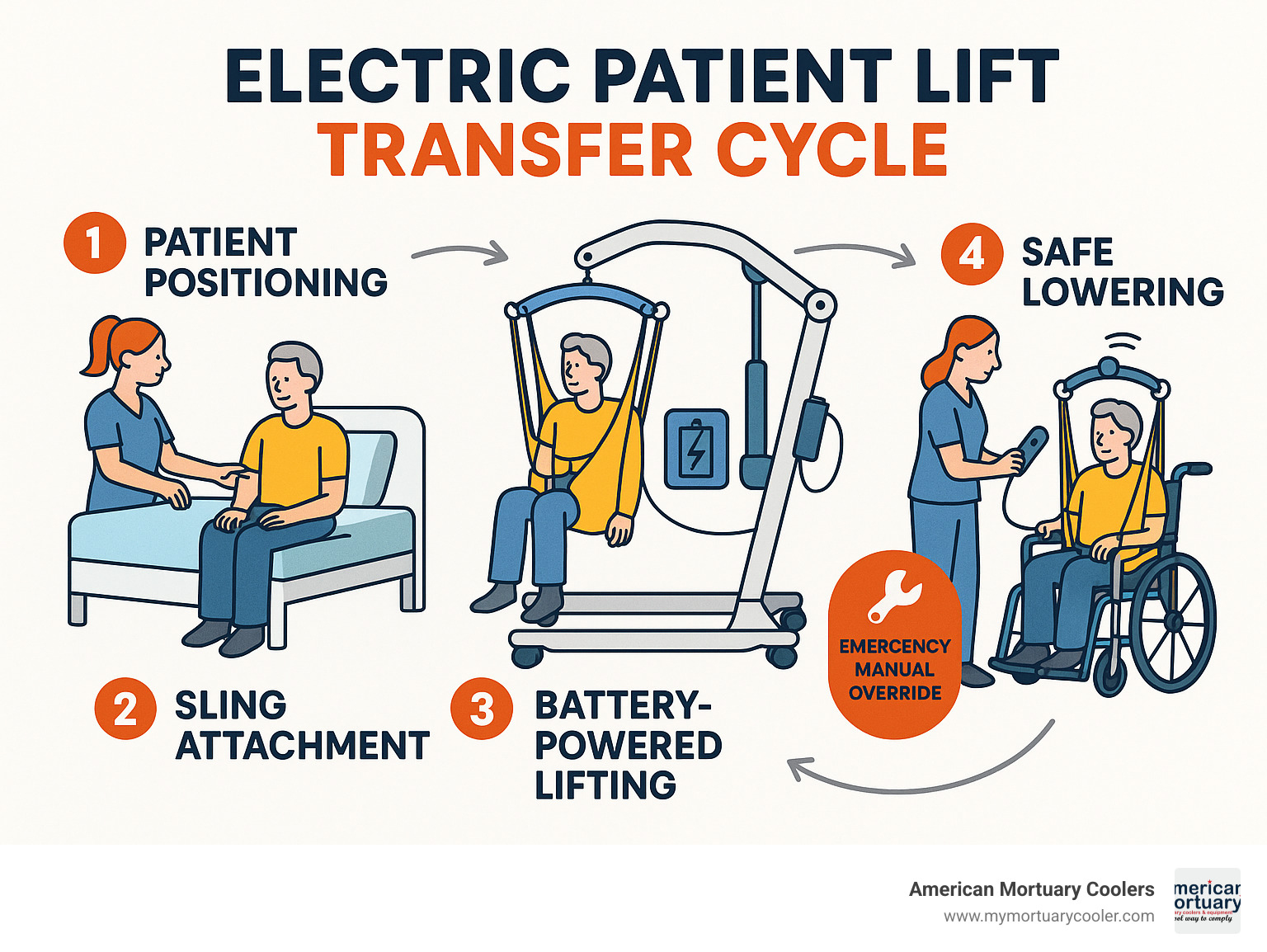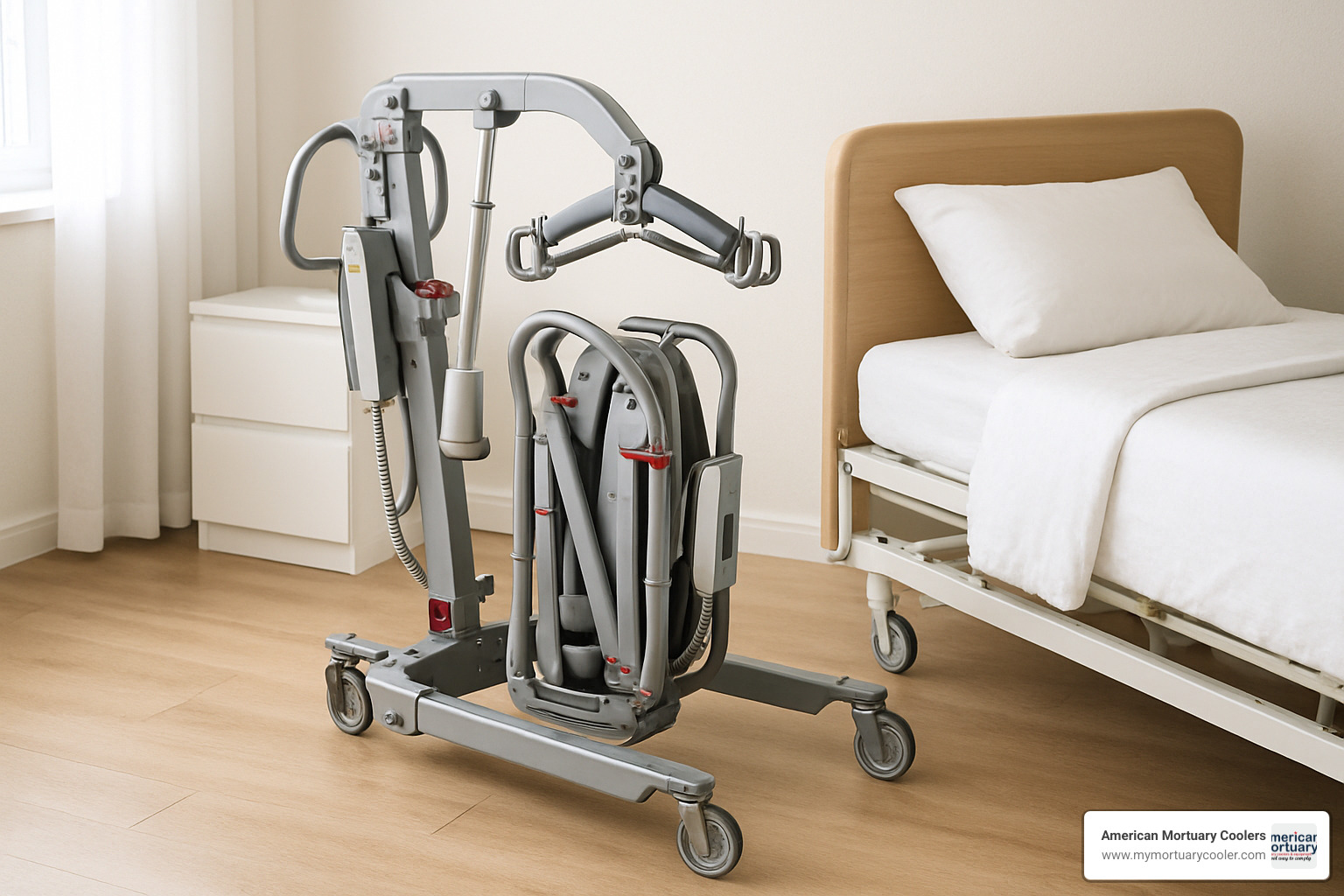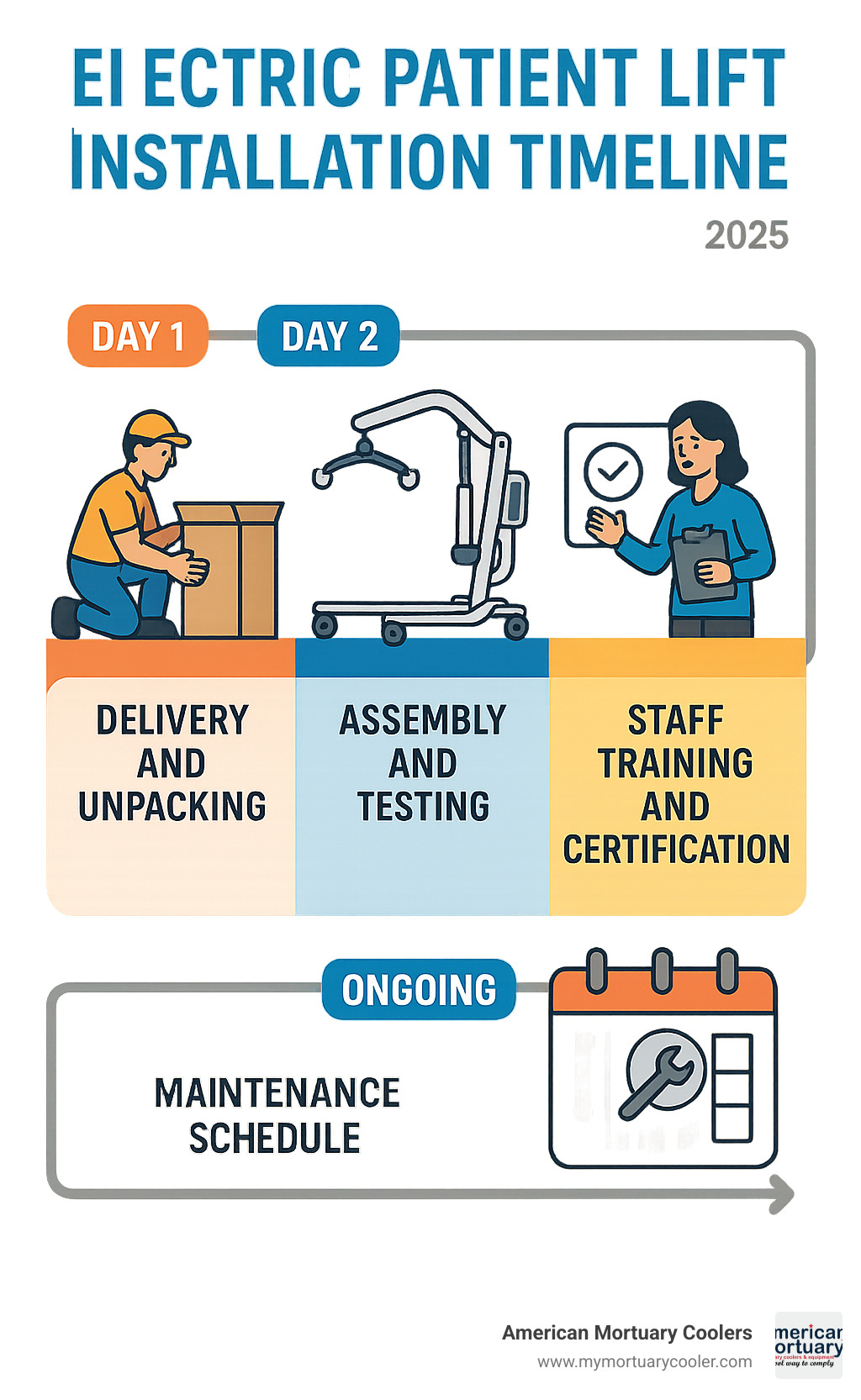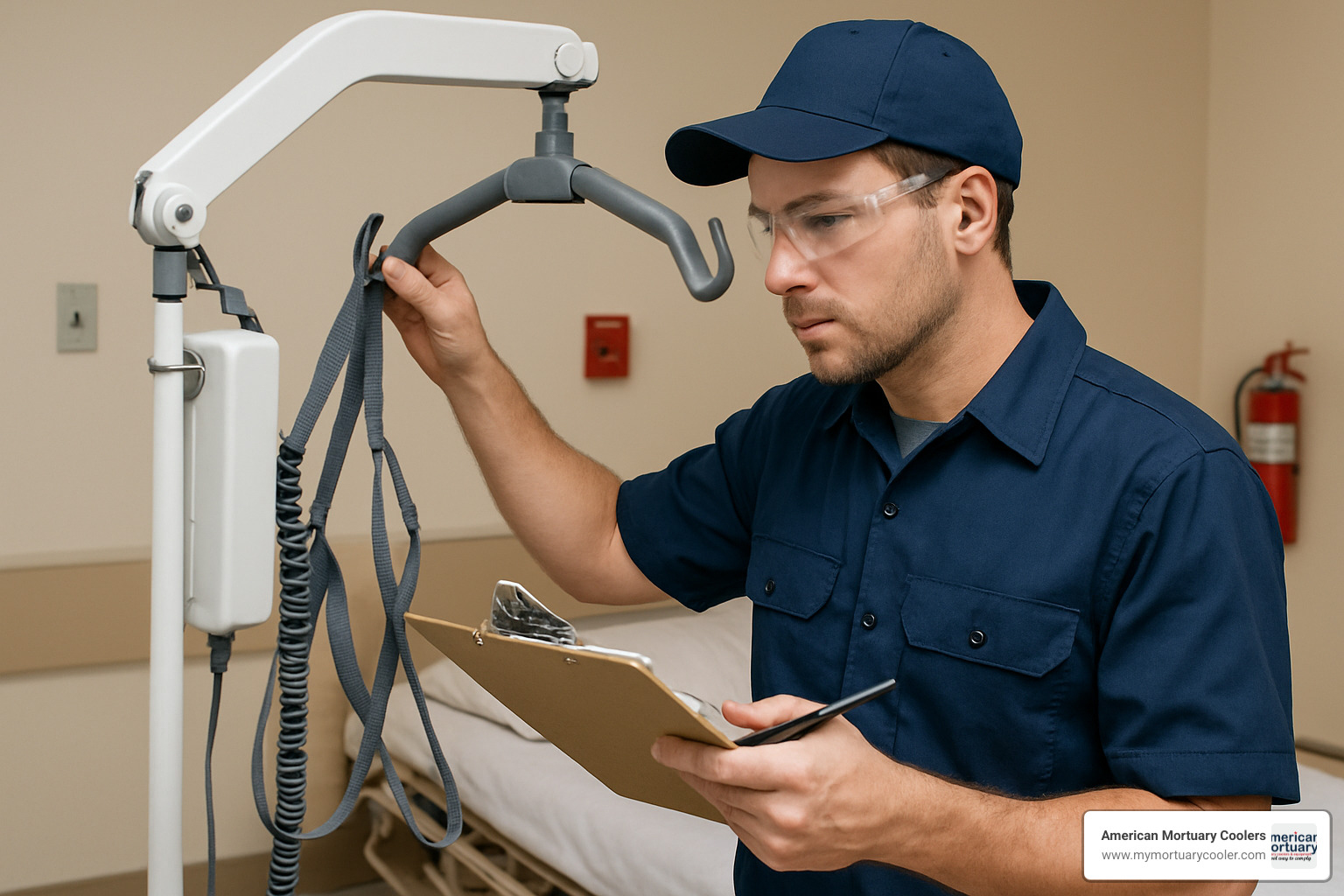
The Ultimate Guide to Comparing Electric Patient Lifts
Why Electric Patient Lifts Are Essential for Safe Patient Transfers
Electric patient lifts are battery-powered mechanical devices designed to safely transfer individuals with limited mobility between beds, chairs, wheelchairs, and other locations. These lifts reduce caregiver strain and injury risk while maintaining patient dignity during transfers.
Key Benefits of Electric Patient Lifts:
- Weight Capacity: Handle patients up to 700 lbs (bariatric models available)
- Battery Operation: Provide consistent, smooth lifting without manual effort
- Safety Features: Include emergency manual lowering and battery backup
- Versatile Use: Support bed-to-chair, floor-to-bed, and seat-to-seat transfers
- Cost: Starting at approximately $1,395 USD
- Applications: Home care, hospitals, rehabilitation centers, and long-term care facilities
The demand for electric patient lifts continues to grow as healthcare facilities prioritize both caregiver safety and patient comfort. Research shows these devices significantly reduce the risk of caregiver back injuries while ensuring dignified patient handling.
Electric lifts offer several advantages over manual models, including consistent lift speeds, reduced physical strain on operators, and the ability to perform up to 90 lifts per battery charge. Many models feature removable batteries to eliminate downtime and six-point cradle systems that enable lifting from nearly any position, including emergency floor rescues.
I'm Mortuary Cooler, a national-level mortuary cooler supplier with experience in healthcare equipment including electric patient lifts and related transfer systems. My background in medical equipment supply has given me insights into the selection, installation, and maintenance requirements that ensure optimal performance and safety.

Electric patient lifts glossary:
Understanding Electric Patient Lifts: How They Work & Who Benefits
Electric patient lifts use a battery-powered actuator that smoothly drives a boom and mast assembly up and down. The handheld control allows caregivers to operate the lift with gentle button presses, maintaining complete control over lifting speed and height. The adjustable base spreads wide enough to slide under beds and around wheelchairs.
Most electric patient lifts handle weight capacities between 400 and 700 pounds, with specialized bariatric models supporting even heavier loads. The battery system provides power for approximately 90 lifts per charge - enough for even the busiest caregiving shifts.
Home care becomes more manageable when family caregivers can safely transfer their loved ones without injury risk. The portable nature of many electric lifts works well in residential settings, even in cramped hallways and tight bedrooms.
Hospitals and medical centers see immediate benefits as clinical staff can focus on patient care instead of struggling with transfers, and workplace injuries drop significantly. The consistent, smooth operation keeps patients more comfortable during stressful times.
Rehabilitation centers find electric lifts invaluable for positioning patients safely during therapy sessions. Physical and occupational therapists can concentrate on treatment rather than wrestling with manual lifting equipment.
For bariatric care, specialized high-capacity electric lifts make safely transferring patients weighing 500+ pounds possible without serious risk to everyone involved.
Electric Patient Lifts vs Manual Models
Electric patient lifts deliver consistent lift speed every time, eliminating the jerky, unpredictable movement that comes with manual hydraulic pumping. Patients feel more secure, and caregivers can focus on positioning rather than operating machinery.
Manual lifts demand real physical effort from caregivers. That hydraulic pump doesn't operate itself, and after a long shift, the caregiver strain becomes obvious. Electric models eliminate this entirely - just press a button and let the motor do the work.
The battery backup systems in quality electric lifts ensure you're never stuck mid-transfer during power outages. All good electric lifts include manual lowering mechanisms as a safety net. If everything goes wrong, you can still safely lower patients using the emergency override.
Electric Patient Lifts in Home and Facility Settings
Electric patient lifts excel in their versatility. Seat-to-chair transfers, the most common daily task, become genuinely effortless. The smooth, controlled movement reduces patient anxiety and gives caregivers confidence.
Floor rescue capabilities represent the most critical application. When someone falls, electric lifts with six-point cradle systems can safely lift individuals from floor level. Without this equipment, you'd need multiple caregivers or emergency responders.
Pool transfer applications open up therapeutic opportunities that would otherwise be impossible. Waterproof electric lifts allow safe access to therapeutic pools and specialized bathing areas.

Portable frames make electric lifts practical for multi-room use or travel. Many models fold completely without tools, fitting into closets or car trunks.
Infection control benefits emerge from the smooth, controlled operation. Less patient stress means fewer complications, and the ability to thoroughly clean and sanitize electric lifts between uses supports strict healthcare hygiene protocols.
Comparing Lift Types, Key Features & Accessories
Electric patient lifts represent one option in a family of lifting devices, each with distinct advantages. Manual lifts rely on hand or foot levers to operate hydraulic systems - the basic, no-frills option requiring significant physical effort. Hydraulic lifts use motor-pressurized fluid for lifting, reducing manual work. Power lifts use motors to pressurize hydraulic fluid automatically, while electric lifts operate directly through battery or electrical outlet power.
| Lift Type | Power Source | Operation | Caregiver Effort | Typical Cost Range |
|---|---|---|---|---|
| Manual | Hand/Foot Lever | Hydraulic Pump | High Physical Demand | $500-$1,000 |
| Hydraulic | Motor + Hydraulic | Pressurized Fluid | Moderate | $800-$1,500 |
| Power | Motor + Hydraulic | Automated Hydraulic | Low | $1,200-$2,000 |
| Electric | Battery/Outlet | Direct Electric | Minimal | $1,395-$5,000+ |
Sit-to-stand lifts work differently from full-body lifts, supporting users who still have some muscle control but need assistance with standing and sitting motions. They're perfect for patients in rehabilitation or those maintaining independence while needing assistance.
The choice between ceiling lifts and floor lifts often comes down to space and installation preferences. Ceiling lifts mount on overhead track systems and glide smoothly around rooms without taking up floor space. Floor lifts offer complete portability without permanent installation.
Quality electric patient lifts come standard with spreader bars that distribute lifting forces evenly across slings, preventing uncomfortable pressure points. Emergency stop features provide immediate response capability - a critical safety feature that can prevent accidents.
Sling & Accessory Selection
Universal slings handle most general transfers, but divided-leg slings work better for toileting transfers, giving patients and caregivers easier access while maintaining support and dignity.
Hygiene slings include strategically placed openings that allow personal care without removing the sling entirely - a game-changer for patients who need frequent assistance with toileting or bathing.
Scale integration adds valuable functionality that eliminates separate weighing procedures. Some electric patient lifts include built-in digital scales that weigh patients during transfers, especially valuable in clinical settings where regular weight monitoring is required.
Gait training capabilities expand therapeutic applications beyond simple transfers. When lifts include removable footplates and appropriate boom positioning, physical therapists can use them to support patients during walking practice.
Proper sling sizing follows specific guidelines: Small slings fit 24-34" chest measurements, Medium handles 34-44", Large covers 44-48", and XL accommodates 48-55" chest measurements. Using the wrong size compromises both safety and comfort.
More info about Ultimate Sling Checklist
Safety Features That Matter
Six-point cradle systems represent the gold standard for electric patient lifts. These systems distribute lifting forces across six attachment points instead of four, providing superior stability and enabling lifts from virtually any position, including emergency floor rescues.
Low-profile legs slide easily under beds, bathtubs, and other furniture, expanding transfer possibilities dramatically. In home care settings where every inch of space matters, this feature can mean the difference between successful transfers and rearranging furniture.
Manual override capabilities ensure patient safety even during complete power failures. Quality electric patient lifts include manual lowering mechanisms that operate independently of battery power - your backup plan for safely lowering patients during emergencies.

Removable battery systems eliminate downtime frustration. Instead of waiting for batteries to charge, you can swap them out and keep working. Busy facilities often maintain multiple batteries in rotation.
ISO certification and other safety standards provide peace of mind that your lift meets rigorous testing requirements. Look for FDA approval, CE marking, and ISO 9001 certification as indicators of quality manufacturing and safety compliance.
Buying & Funding Guide for Electric Patient Lifts
Entry-level electric patient lifts start around $1,395, while heavy-duty bariatric lifts can reach $5,000 or more. This range reflects real differences in weight capacity, features, and construction quality that matter for daily use.
The true cost of ownership goes beyond the purchase price. You'll need to replace batteries every 2-3 years and budget for routine maintenance. However, these ongoing costs are usually smaller than what facilities spend on caregiver injuries from manual lifting. Many healthcare facilities find their electric lifts pay for themselves through reduced workers' compensation claims.
Rental options offer flexibility for short-term needs or trial periods. Monthly rates typically run $150-$400, making this smart for recovery periods, temporary caregiving, or testing different models before purchasing.
Insurance coverage can be tricky but worth the effort. Medicare may cover lifts for home use when your doctor documents medical necessity. Private insurance plans vary widely, so getting pre-authorization is essential. Medicaid coverage differs by state but often includes durable medical equipment like patient lifts.
When selecting weight capacity, choose a lift that exceeds your heaviest anticipated user by at least 50 pounds. This safety margin ensures reliable operation and extends equipment life. Consider the footprint - you need space not just for the lift itself, but for the base to spread wide during operation.
Portability needs should drive your model selection. Foldable lifts trade some stability for transport convenience, while fixed-base models provide maximum stability but stay in one location.
Top Brands & Models Overview
Medline dominates the market with their Powered Base Electric Patient Lifts, available in both 450 lb and 700 lb capacity models. These feature six-point cradle systems and deliver about 90 lifts per battery charge, making them favorites in busy healthcare facilities.
Bestcare focuses on user-friendly design with their PL400HE Full Body Electric Mobile Patient Lift. With tool-free assembly and 400 lb capacity, these models shine in home care settings where family caregivers need approachable equipment.
Drive DeVilbiss Healthcare offers comprehensive product lines spanning battery-powered, hydraulic, and bariatric models. Their lifts often feature removable batteries and flexible cradle configurations, with weight capacities reaching 500 lbs.
Invacare builds the respected Reliant series of battery-powered patient lifts, known for reliability and comprehensive safety features. Their models often include power-opening low bases and advanced control systems.
Arjo manufactures premium lifts including the Maxi Move Powered series for bariatric patients up to 500 lbs. These lifts emphasize clinical-grade construction and advanced safety systems for hospital and long-term care environments.
Quick-ship programs from major suppliers can reduce delivery times to 1-2 weeks for popular models, though custom configurations may require longer lead times.
Installation & Training Essentials
Ceiling track setup requires professional installation and structural assessment. These systems can support weights up to 1,000 lbs but must be properly anchored. Installation typically takes 1-2 days and includes track mounting, motor installation, and comprehensive safety testing.
White glove delivery services include unpacking, assembly, and initial demonstration. These services typically add $200-$500 to your purchase price, but ensure proper setup and eliminate assembly errors that could compromise safety.
Caregiver training should cover proper sling selection and attachment, safe operating procedures, emergency protocols, and routine maintenance tasks. Most manufacturers provide excellent training materials, and many offer on-site training sessions for facility purchases.

Certification requirements vary by facility type and location. Healthcare facilities typically require documented training for all staff who will operate lifts, while home users benefit from manufacturer-provided instruction even when not legally required.
Documentation should include training records, maintenance logs, and incident reports. This paperwork proves essential for regulatory compliance and liability protection.
Operating, Maintenance & Compliance Standards
Keeping your electric patient lifts running safely requires consistency. Daily maintenance is like checking your car before a road trip - a few minutes of attention prevents hours of problems later.
Your daily routine should start with checking the battery level indicator. Most lifts show battery status clearly, and you'll want to see a full or nearly full charge before starting your shift. Next, give the slings a quick visual inspection, looking for tears, fraying, or damaged stitching. Finally, test that emergency stop button - it's your safety net.
Battery charging becomes second nature with overnight charging cycles, similar to charging your phone. The battery level indicators give you plenty of warning - usually 15 to 30 minutes of operation time - before power runs low. Don't push it when you see that low battery warning.
Sling inspection deserves special attention because these fabric components take the most wear and tear. Look for signs of stress, particularly around attachment points where clips connect to the spreader bar. If you spot any damage - even small tears or loose stitching - replace that sling immediately.
For cleaning protocols, you can use standard healthcare disinfectants on most lift surfaces, but be careful around electronic components. A damp cloth works better than spray bottles near control panels and battery connections.
CSA and UL marks on your lift indicate it meets North American safety standards, while FDA guidance ensures medical device compliance. F-Tag 323 becomes important if you work in long-term care facilities, as surveyors specifically look for accident prevention measures during inspections.
More info about maintenance tips
Troubleshooting Common Issues
Low battery alerts give you about 15 to 30 minutes to finish what you're doing and get to a charger. Ignoring these warnings can damage the battery permanently and potentially leave someone stuck mid-transfer.
Jerky actuator movement usually means low battery, something blocking the mechanism, or parts that need lubrication. Start with checking that battery level first. Then look around the lift base and mast for anything interfering with smooth operation.
Sling wear patterns tell a story about how your lift is being used. If you notice excessive wear in specific spots, it might indicate improper sizing or attachment techniques. Document these patterns to identify training opportunities.
Error codes vary between manufacturers, but they're usually trying to tell you something important. Don't ignore them - check your operator manual for what each code means. Common codes indicate overload conditions, mechanical problems, or electrical issues needing professional attention.
Service calls should happen sooner rather than later when problems go beyond basic troubleshooting. Attempting complex repairs without proper training can void warranties and create safety hazards.
Preventative maintenance schedules typically include monthly detailed inspections, quarterly lubrication of moving parts, and annual professional servicing. Following these schedules prevents most breakdowns and keeps your lift running for years.
Regulatory & Safety Audits
Annual inspections by qualified technicians aren't just good practice - they're often required by regulation and insurance policies. These comprehensive checkups include mechanical testing, electrical safety verification, and thorough review of maintenance documentation.
Documentation requirements serve important purposes. Maintenance logs show you're taking care of equipment properly. Training records prove staff knows how to operate lifts safely. Incident reports help identify patterns that might prevent future problems.
Staff competency verification should happen when someone first starts using lifts and then annually. Competency means more than knowing which buttons to push - it includes proper sling selection, emergency procedures, and basic troubleshooting skills.
OSHA ergonomics guidelines strongly emphasize mechanical lifting aids as the best way to prevent workplace injuries. Electric patient lifts directly support these guidelines by eliminating manual lifting that causes back injuries among healthcare workers.

Facility policies should spell out everything clearly: how to select the right lift for each situation, what training is required, when maintenance should happen, and how to report incidents. Well-written policies provide clear guidance for staff and show regulatory inspectors that your organization takes safety seriously.
At American Mortuary Coolers, we understand the importance of reliable equipment in healthcare settings. While our specialty lies in mortuary coolers and funeral industry equipment, we appreciate the critical role that properly maintained electric patient lifts play in ensuring both patient dignity and caregiver safety throughout all healthcare environments.
Frequently Asked Questions about Electric Patient Lifts
How much weight can an electric patient lift handle?
Most standard electric patient lifts safely handle between 400 and 450 pounds, which covers the vast majority of transfer situations you'll encounter. But if you're caring for larger patients, don't worry - bariatric models step up to support 500 to 700 pounds, and some specialized ceiling-mounted systems can handle an impressive 1,000 pounds.
Here's the key safety tip I always share: choose a lift with a weight capacity that exceeds your heaviest patient by at least 50 pounds. This safety margin ensures reliable operation and protects both the patient and equipment from stress-related failures.
The weight limit includes everything being lifted together - not just the patient, but any medical equipment, heavy clothing, or mobility aids that come along for the ride. When you're unsure, it's always better to go with a higher-capacity model rather than pushing the limits.
Can one caregiver operate an electric patient lift safely?
Absolutely! That's exactly what electric patient lifts were designed for. The battery-powered operation takes all the physical strain out of transfers, allowing one person to smoothly control the entire process with just the push of a button.
The beauty of electric operation is its consistency - you get the same smooth, controlled lift every single time, whether you're a seasoned nurse or a family caregiver learning the ropes. No more struggling with manual pumps or worrying about your physical strength affecting the transfer quality.
That said, your facility might have policies requiring two caregivers in certain situations. We often see this requirement for confused or agitated patients, emergency floor rescues, or when transferring someone close to the weight limit. The lift itself works perfectly fine with one operator, but that second person provides extra patient management and safety support.
What happens if the power fails during a transfer?
This is probably the most common concern I hear, and I completely understand why - nobody wants to imagine being stuck mid-transfer with a patient suspended in the air. The good news is that quality electric patient lifts are designed with exactly this scenario in mind.
Every reliable electric lift includes a manual lowering system that works completely independently of battery power. If your battery dies during a transfer, you can safely lower the patient using an emergency manual override - usually a simple hand crank or lever system that provides controlled descent even with zero electrical power.
These manual backup systems are intentionally designed to be straightforward and intuitive. Even under stress, caregivers can quickly engage the manual lowering mechanism and bring patients down safely. The descent is controlled and smooth, just like normal operation.
Most electric patient lifts also give you plenty of warning before reaching this point. Low battery alerts typically sound 15 to 30 minutes before complete power depletion, giving you ample time to finish your current transfers and get the battery on the charger. It's rare to be caught completely off guard by a dead battery if you're paying attention to the warnings.
Conclusion & Next Steps
Choosing the right electric patient lifts can transform how caregivers approach patient transfers, turning what was once a physically demanding and potentially dangerous task into a smooth, dignified process. The evidence is clear: electric patient lifts deliver measurable benefits that extend far beyond their initial cost, with facilities reporting dramatic reductions in workplace injuries while patients experience greater comfort and dignity.
At American Mortuary Coolers, we've spent years understanding what makes medical equipment reliable and long-lasting. While our specialty lies in crafting custom mortuary coolers for funeral homes across the contiguous 48 states, our experience with durable healthcare equipment has taught us valuable lessons about quality, maintenance, and long-term performance that apply directly to patient lift selection.
Improved safety starts with having the right equipment, but it doesn't end there. The most sophisticated electric patient lift won't deliver results without proper training, regular maintenance, and a commitment to following safety protocols.
Your next steps should focus on matching your specific needs with the right equipment. Consider your weight capacity requirements, space constraints, and whether portability matters for your situation. Don't forget to factor in ongoing costs like battery replacement, maintenance, and training when calculating your budget.
Informed buying decisions require looking beyond the sticker price. A less expensive lift that breaks down frequently quickly becomes more costly than a quality unit that operates reliably for years. The brands and features we've discussed represent proven solutions that deliver consistent performance.
Building caregiver confidence happens when staff know they have reliable tools that work every time. When caregivers trust their equipment, they can focus on patient care rather than worrying about mechanical failures or safety concerns. This confidence translates into better patient outcomes and improved job satisfaction.
Selecting an electric patient lift is ultimately about people - the caregivers who use them daily and the patients who depend on them for safe, comfortable transfers. The technical specifications matter, but the human impact matters more.



